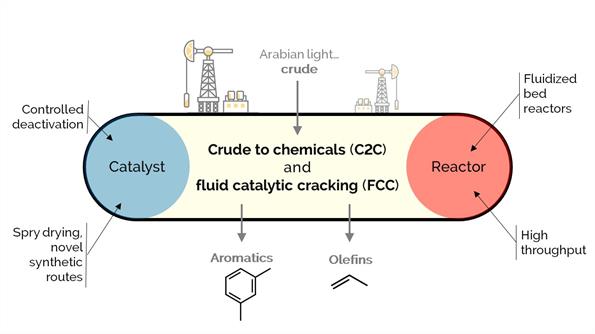
The direct catalytic cracking from crude oil to chemicals could dominate the petrochemical industry shortly, with less fuel consumption and increasing production of light olefins and aromatics. We aim to simplify the refinery into a unique one-step conversion scheme, targeting the production of the most demanded petrochemicals.
Using a bottom-up holistic approach, we design a catalytic crude-to-chemicals process toward this goal using a bottom-up holistic approach. We investigate advanced reactors with intrinsic kinetic data and controlled hydrodynamics to improve the process. We study the non-linear multiscale phenomena by coupling the hydrodynamics, heat transfer, and reaction kinetics.
We use particle image/tracking velocimetry experiments, kinetic modeling, computational particle fluid dynamic modeling, and optimization approaches to improve operating scenarios and develop innovative reactor prototypes.
We focus on the catalyst, reactor, and process levels for system enhancement and intensification. We are optimizing several state-of-the-art laboratory and pilot-scale units, including a circulating Berty, downer, and multifunctional fluidized bed reactors.

The effect of co-cracking of high-density polyethylene (HDPE) or its pyrolysis wax together with vacuum gasoil (VGO) has been studied. The aim is to determine the content, nature, and location of coke while analyzing the impact on product distribution in the process. Four different feeds were used (VGO, VGO + 5 wt% HDPE, VGO + 20 wt% of wax, and 100 wt% wax) in experiments performed in a laboratory-scaled riser simulator, with similar conditions to those of the fluid catalytic cracking(FCC) unit: equilibrium catalyst; 530 °C; catalyst/feed mass ratio, 5; contact time, 6 s. The results of the different characterization techniques of the deactivated catalyst and the coke indicate that the catalyst foulingdecreases notably by incorporating these waste streams, changing its nature to a more aliphatic (olefinic) one and its location towards the zeolite micropores. On the contrary, the coke formed from the VGO is more evolved and mainly constituted by polyaromatic components deposited on the mesopores of the catalyst matrix. Product distribution is also affected, increasing the yield of light cycle oil and keeping a relatively similar gasoline yield, with greater olefinity and lower aromaticity. Thus, the FCC shows great perspectives to valorize polyolefins, present in waste plastics, at great scale.